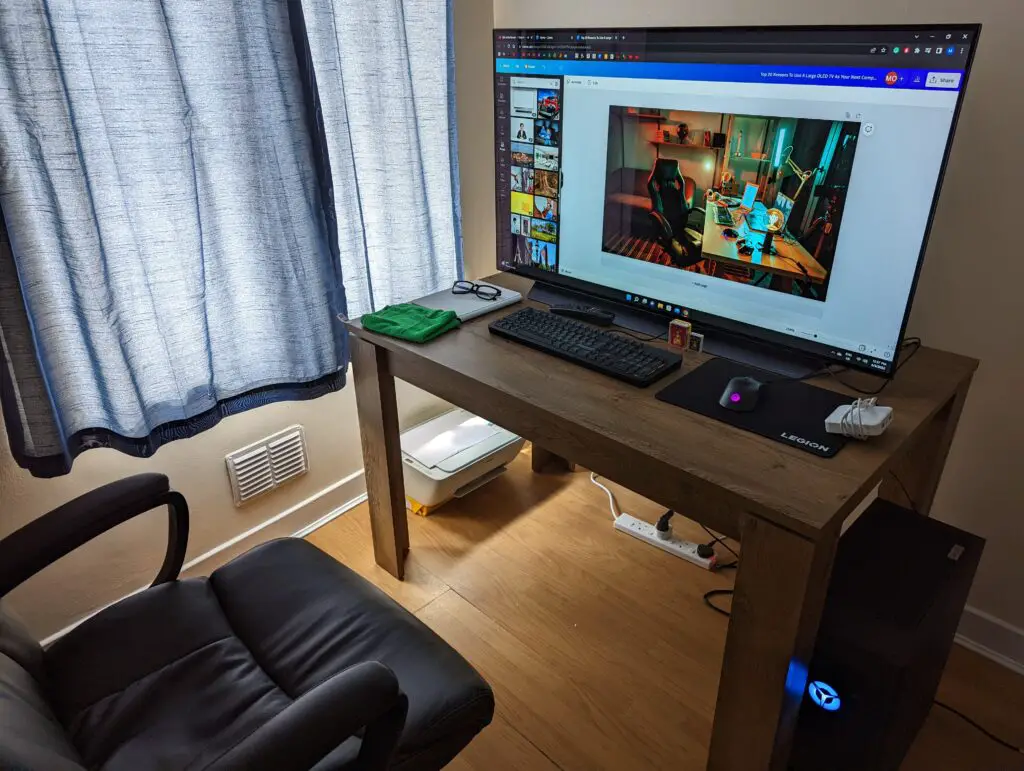OLED smart TVs currently hold the crown as some of the best TVs available on the market today. Organic Light-Emitting Diode TVs offer deeper blacks (thanks to individual pixel illumination), a more vibrant display, more energy efficiency, and the option of flexible screens or curved sets.
Like most smart TVs, OLED TVs come in a large variety of sizes, and although a 75” monster OLED sounds great on paper, using it as an up-close and personal computer monitor will almost certainly lead to a poor viewing experience.
I’ve been using a 48-inch OLED TV as my main computer monitor for about 4 months now and it has been the best home computing experience I have ever had.
I wouldn’t recommend using anything bigger than 48 inches. But, for me, I wouldn’t go any smaller, either.
A 48-inch OLED TV as a computer monitor sat on a massive desk hits the sweet spot.
There is a lot to like about this setup so let’s get into the 20 biggest benefits.

Table of Contents
A Massive OLED Screen Is Just Awesome
The wow factor just doesn’t wear off when you use a massive OLED as your daily driver. Months into the experience, you’ll switch on a 4K HDR video on YouTube, sit back in your chair and be like wow! This looks incredible.
And the computing experience, in general, is just awesome. Everything is big, vibrant, and in high definition.
Multitasking is also great. You can divide up multiple windows any which way you like for work or fun.
The gaming experience is also awesome.
So long as you have it positioned at the right distance—you don’t want the thing to melt your eyeballs—a massive OLED screen will be one of the most pulse-pounding, visual experiences that you can get on a PC game.
It’s great for consoles and all, but there are no consoles that can rival PCs in pure, unadulterated, graphical prowess. Imagine harnessing that power on a 60” plus OLED screen that’s wall-mounted. It’s hard to argue with the profound epicness of such a feat.
That’s especially true with games like Elden Ring, which happens to be outselling every game in recent existence. It gives new meaning to the dex/faith build slinging around Ancient Dragon Lightning Strike Incantations.
Sure, it’s not the best incantation in the game (it’s really slow), but it will look ridiculously impressive on a massive OLED screen.
Multitasking Is Amazing
Whether you’re gaming, running a Twitch stream, freelancing, or just passing some time, multitasking is a feature we can all use.
Even tablets and smartphones do their best to cater to the growing market of multitasking customers who simply need to do more than one thing.
And, what’s better for multitasking than having a massive amount of screen real estate?
You could divide your massive OLED display into two large halves – one half for writing and the other for researching or one half for watching YouTube and the other half for browsing the web.
You can also divide the screen into 3 fairly large-sized sections if you need to divide your attention across 3 things at once.
It’s also great for if a child comes into the room and demands that you put on something for them to watch – you can partition 1/3 of your giant OLED monitor for them to watch SpongeBob while you continue with your work.
Of course, multitasking when it comes to gaming means you need a fast refresh rate and HDMI 2.1. Unfortunately, that means a much higher price tag because you are going to have to go for a premium name for a premium experience.
The LG C1 OLED is the perfect huge monitor experience that you’ve been craving. It starts as small as a 48” and that’s the biggest size you’ll want to go with for a computer monitor.
The LG C1 features a Variable Refresh Rate (VRR) and can easily handle HDR content, with games rendered in 4k resolution at 120 fps and a 120Hz refresh rate.
Dolby Vision capable, the LG C1 won’t come cheap but is a great deal compared to other high-end computer monitors that still won’t hold a candle to it.
You can also pair it with an LG SP9YA Soundbar for an audio upgrade.
Streaming Video On A Large OLED Display Is Like Watching Your Own Private Cinema
There are two ways to get the best and closest thing to a movie theater in your own home. You could purchase a laser projector or you could slap a large OLED TV on your desk and sit just far enough away so that the screen fills your vision.
Using a large OLED as a computer monitor means you are never more than a couple of clicks away from watching your favorite movies, TV shows, and documentaries in stunning 4K HDR on sites like Prime Video, Netflix, YouTube, Rakuten TV, Apple TV Plus and Disney +.
Don’t think that the laser projector is going to cost you any less either, because they are extremely expensive, especially if you want the high refresh rate and features of a premium OLED.
Having a giant OLED TV on your desk is the ultimate cinematic experience for when you want to take a well-earned break from work or just kick back.
Even a virtual reality, Oculus Quest 2 experience isn’t going to replicate what a giant OLED can because it simply lacks the refresh rate, resolution, and an incredible display resolution, some of which you can find in 8k.
Perfect Blacks Make Colors And Contrast Look Amazing
If there is one area where OLEDs blow away the competition, it’s in the TV’s ability to give you a true black. That’s because the pixels in an OLED are all capable of emitting their own, individual color or, just turning off altogether to give pure black.
This means you can enjoy a superior image quality during your daily computing. Images will be clearer. Blacks will be blacker and colors will be more vibrant.
So, instead of having a pixel that is trying to reduce the light to the lowest level or combine enough colors to replicate black, OLED pixels just turn off completely, which gives you the truest black that you can possibly get, and that sets the stage for better all-round picture quality.
Upscaling On OLED TVs Makes Low Definition Content Look Better
Upscaling has been around for a long time, even since the days where HDTVs were supposed to be able to upgrade standard resolution or 480p. Later, 1080p HDTV sets were supposed to be able to upscale 720p, and so forth. The success rate of such claims was hit or miss.
Now, we are in the era of 4k resolution, with 8k even closer than just being on the horizon. The problem is, although 4k is nearly the standard in most homes, not everything is broadcast in 4k, and not all digital content is streamed in 4k, whether you are gaming or streaming a movie.
That’s where upscaling comes in and Sony, LG, and Samsung have a leg up on the competition.
- Sony Bravia XR Master Series OLED: Sony uses its patented Cognitive XR processor, otherwise known as the (4k Processor X1), for upscaling standard HD resolution to 4k. It utilizes detail enhancement and noise reduction technology.
- Samsung S95B 65” 4K Quantum HDR OLED Smart TV: Besides being a mouthful, this incredible TV features a Neural Quantum Processor for its 4k upscaling. According to Samsung, the processor uses 20 A.I.-powered neural networks to reduce noise and render even standard resolution to near-4k levels.
- LG OLED G2 Series Evo TV: This is LG’s upgrade to the aforementioned LG C1 and it features an A9 Gen 4 A.I. processor for upscaling. Like Sony’s and Samsung’s A.I., the LG A9 Gen 4 does the same thing by using learning algorithms that go so deep it even figures out what genre you’re watching so it can give it the best upscale possible.
Upscaling on your OLED will increase the pixel count on lower-resolution video making it match the pixel count of higher-resolution displays. This means that lower-resolution content, like 480p videos on YouTube, is always going to look a lot better on your OLED than it would on a regular PC monitor.
You Can Take Advantage Of 4K HDMI Ports At 120Hz Refresh Rate
If you want to take advantage of the higher refresh rate then you need the HDMI 2.1 access to give you the best computing or gaming experience. Fortunately, all of the above-mentioned TVs feature HDMI 2.0, 2.0b, or 2.1.
HDMI 2.1 is pretty new in terms of HDMI technology, which is starting to rapidly advance much in the way that Bluetooth took off. If you are looking at HDMI 2.1, which you should if you want the ultimate smooth computing or gaming experience, you will need a specific HDMI cable because not just any HDMI cable will do.
There are several things the HDMI 2.1 opens up that HDMI 2.0b and below can’t do.
- Dynamic HDR
- eARC (Enhanced Audio Return Channel)
- Variable Refresh Rate
- Quick Media Switching
- Display Stream Compression
- Quick Frame Transport
- Auto Low Latency Mode
Although all of these things will improve your daily computing experience, it’s the Variable Refresh Rate that gamers should really look for. It eliminates screen tears by constantly remaining in sync with your rig because it can adapt on the fly, and your refresh rate will always be at the absolute best that it can be.
The Speakers On Large OLED TVs Are Much Better Than On Monitors
If there is one thing that is a considerable drawback for even premium computer monitors, it’s the factory speakers that come built-in. They’re never all that great, however, if you are using a giant OLED TV instead, you will generally have better speakers.
Now, the built-in speakers on an OLED TV are not going to blow anyone’s socks off. However, you can bet every remaining penny that you have, after having purchased a giant OLED set, that the built-in speakers will be better than most PC monitors.
A Larger Screen Size Makes You More Productive
For some odd reason, the size of the computer screen does matter. In fact, according to the latest research on the matter, the size of your screen matters more than the speed of your computer when it comes to being more productive.
According to the same research, anything less than 17” makes for a very unproductive person, so imagine what happens when you turn a 17” into 48”.
When you have a larger screen to work on, you can set up more windows to keep the important things you’re working on open and in front of your eyes spending less time searching through tabs and windows for what you were working on 5 minutes ago.
Maybe it’s the entertainment value of a mega-gigantic TV on your desk or maybe it’s all about aesthetic-based motivation.
Either way, a larger computer screen, or a humongous smart TV screen converted into a computer screen, in this case, seriously promotes productivity.
Related Article: 12 Reasons Why OLEDs Are Great For Gaming
You Spend Less Time Searching Through Tabs And Windows
It could be that this has something to do with that productivity thing we just pointed out. It kind of seems obvious that if you can see more open windows at the same time and search through tabs and windows faster, overall productivity would increase.
Also, when things are bigger and more vibrant, we take in the information on the screen more easily.
The main reason is that you can see better. Humans are visual creatures and a huge, incredibly detailed, 4k resolution visual is the kind of thing that’s right up our alley. This is especially true for gamers, since we have a knack for increased hand-eye coordination and decreased lag time between visual input and reaction.
A Massive OLED TV As A Monitor Does Away With The Need To Use Multiple Monitors
A large amount of screen real estate does away with the need for additional screens for the purpose of work, entertainment, and gaming.
If you’re a programmer, you won’t need two separate screens for writing and running your code. A large OLED will be enough for you to divide into separate windows that will do the job.
It’s the same for design work. You can use the space a large OLED TV as a monitor provides to open multiple windows to run applications like Adobe Photoshop, open additional toolbars, search through folders for files, etc.
If you’ve ever felt cheated by that huge, black or white (or whatever the color your computer is) line between one screen and the next, a giant OLED eliminates that problem in a jiffy. Now, not everybody uses Windows 11, or Windows at all for that matter, but it has a feature called “snap windows,” which can open up multiple windows in a customizable grid.
Windows 11 isn’t the first Operating System to ever come up with this multitasking gem, but it works wonderfully on an OLED screen that is 48” diagonal.
Just half of your display is going to be as big as most people’s computer monitors.
OLED Screens Are Easier On Your Eyes
It all boils down to blue light and even though OLEDs are putting out the same level of brightness and colors that an LED, LCD, Plasma, or you name it would also put out, the blue light is less damaging and less intense from OLEDs.
There was a recent study conducted by Professor Jou and his research group at NTHU. The study compared blue right damage between an iPhone 7’s LCD screen and the iPhone XS Max’s AMOLED screen.
The test confirmed that the iPhone XS Max’s screen was a lot safer to look at than the iPhone 7’s LCD.
The Best Large OLED TVs Have Loads Of Input/Output Ports For Connectivity
Nowadays, it’s pretty standard for even your low-end smart TVs to have a fair amount of connection ports. Premium-level OLED sets are another monster entirely.
For instance, despite the relative newness of HDMI 2.1, the LG G2 OLED mentioned above comes with 4 HDMI 2.1 ports and 3 USB 2.0 ports, and an RF coaxial plug.
You can expect the same from competing platforms Sony and Samsung, with similar sets in terms of technology. All of the HDMI ports support NVIDIA G-Sync, AMD FreeSync, or equivalent technology, as well as NVIDIA GeForce Now.
Large OLED TVs Are Getting Cheaper All The Time
As with all newly introduced technologies, OLED was introduced with massive price tags that were out of reach for most consumers, or at least not very plausible because somebody has to pay the bills after all.
However, OLED TVs aren’t going to remain on an uber-expensive platform forever and with technologies like Mini LED, the price tags are trending downward.
The only drawback to going with a cheaper OLED set is that you run the risk of ending up with a lower refresh rate.
So, do your homework before you ransack your bank account.
A Family Member Can Watch One Half Of The Screen While You Work Using The Other Half
The beauty of multitasking on such a large screen is that you don’t have to be the only one involved in multitasking. With a large, OLED TV screen as your PC monitor, you have more than enough real estate for one person to catch John Wick 3 while you work on your blog or update social media.
And, if you play together, it stands to reason that you can work together as well. You can run your program on the right side of the screen while someone else works on their blog on another. You don’t have to work on your blog, of course, but you get the point.
Even Large OLEDs Are Very Thin And Reasonably Light For Their Size
OLEDs are nowhere near as power-hungry as some of their predecessors, especially those nearly antique plasma TVs. Thanks to better cooling technology and improved hardware, OLED TVs are thinner than ever before, which makes them an excellent choice for wall mounting.
Imagine being able to swing that flat screen off the wall with an extension arm, flipping it to face far left, and tilting it downward about 20° before you rock out a 30-minute session of Call of Duty: Warzone, DOTA 2, or whatever floats your boat.
A Large OLED TV As A Monitor Will Be Brighter Than An LED Monitor
The beauty of an OLED is that it doesn’t need backlighting to achieve a brighter output than older LCD and LED models and it can do all of that without the blue-light eye strain.
That’s because OLEDs can control the brightest of each individual pixel and the deeper blacks highlight the visuals to a larger and more nuanced degree.
When you are watching an OLED, you are getting a brighter visual without that “too bright” washout effect that seems to diminish background visuals.
OLED TVs Consume Less Power Than LED Displays
OLED TVs also offer more long-term value than LED TVs in terms of power consumption. As it turns out, the fact that OLED pixels can turn completely off at an individual level saves power.
Older TV technologies rely on backlighting to achieve brightness and this can often result in too much white light, over saturation, and more of a greater consumption of power.
LED TVs on the other hand, have all of their pixels lit up all of the time, which makes a slight difference in power consumption over time.
They Have Wider Viewing Angles
When your display has a wider field of view, you can swivel off to the side in your chair or get up and walk around the room and still see most of the information shown on the screen.
OLED TVs have the widest viewing angles available on the market and it’s not even close. While you could nudge a few watts here and a few watts there in power consumption comparison, when it comes to the field of view, an OLED simply dominates.
The average viewing angle for an OLED is 70° from the center. The best viewing angle that you can get out of LEDs and even QLEDs is 40° but most of them average around 30° from the center. As you can see, there is very little in the way of competition here.
The Best OLED TVs Have All The Features Of Gaming And High-End Computer Monitors
It wasn’t that long ago that large TVs made horrible displays for gaming. They didn’t output a high enough resolution to present clear visuals, the refresh rate was terrible leading to constant blurriness, and response times and input lag were no one near the levels needed for precise gaming.
Things have changed and large OLEDs are now as great for gaming as the highest-end gaming monitors.
The big names in TV manufacturing, namely Sony, LG, and Samsung, have not been ignorant of the fact that console gamers appreciate crisp, vibrant, and excessively grandiose graphical displays.
So these companies have gone about creating TVs that are loaded with features for console gamers and in the process, made OLED, large screen TVs an invaluable and highly competitive aspect amongst PC gamers as well, including extremely fast response time, auto low-latency mode (a feature in all of the above-mentioned TVs) HDMI 2.1, and a high refresh rate.
Hook Up A Next-Generation Console Along Side Your PC For The Full 4K, 120-Hertz Gaming Experience
All of those ports are there for a reason and that reason is you, plugging in your Playstation 5 or Xbox Series X right next to your PC for the best 4K, HDR, high refresh rate console gaming experience you can get.
It’s especially nice because both consoles and PCs allow for things like Twitch streaming, because why shouldn’t you share the experience?
While you’re at it, throw some of your retro consoles on there as well, like a Super Nintendo, Gamecube, Genesis, Wii, or even a Dreamcast if you can get your hands on one.
There’s nothing at all wrong with gorging on a Spam sandwich while you hammer Bowser in glorious OLED, 4k resolution.



